A Journey from Ancient Greece to Modern Times
With the 33rd Summer Olympic Games well underway in Paris — before you know it they will be Olympic History — it’s an ideal moment to reflect on the modern Olympics, from inception to the present. The Olympics are a unique showcase of both competition and camaraderie; a noble attempt to transcend political and cultural barriers in the name of peace and the brotherhood of man. Like all dreams, the games are imperfect and they have never been able to completely disentangle themselves from international conflicts and other controversies, but they continue to be one of the greatest international achievements born of humanity’s desire to create a better world.
The Ancient Greek Olympics
The ancient Olympic Games originated in Olympia, Greece, in 776 BC and were part of a religious festival honoring Zeus. Athletes competed naked to celebrate the human body and athletic prowess, and winners were awarded a crown of laurel leaves, rather than medals. Their victory and honor was fleeting and would fade as laurel leaves fade. This tradition is the origin of the Participation was restricted to freeborn Greek men, and the city-states of Greece took great pride in sending their best athletes. Representatives from Athens, Sparta, Corinth, and other prominent city-states came together in a rare show of unity. Even during times of war, the Greeks observed the “Olympic Truce,” a period during which hostilities were suspended to ensure safe passage for athletes and spectators traveling to Olympia. This truce underscored the importance of the Games in fostering peace and camaraderie among the often-warring city-states.
Several famous figures from antiquity are said to have participated in the Olympic Games. The renowned Athenian statesman Alcibiades famously entered seven chariots in the races, winning multiple prizes. The philosopher Socrates, known for his contributions to ethics and epistemology, is rumored to have attended the Games, although not as a competitor. Another notable figure is the wrestler Milo of Croton, who won numerous victories and became a legend for his strength and technique.
The ancient Olympic Games continued for nearly 12 centuries until they were abolished in 393 CE by the Roman Emperor Theodosius I, who sought to eliminate pagan practices. The decline of the Games mirrored the decline of the ancient Greek world, as Roman influence grew and the traditional religious and cultural practices of Greece were suppressed. Despite their end, the legacy of the ancient Olympics lived on, inspiring the revival of the Games in the modern era and continuing to symbolize the enduring human spirit of competition and excellence.
Birth of the Modern Olympics
The vision of reviving the Olympic Games came from Pierre de Coubertin, a French educator and historian. Inspired by the ancient Greek tradition and seeking to promote peace and international understanding through sports, Coubertin presented his idea in the late 19th century. He believed that bringing together athletes from around the world to compete in a spirit of friendly rivalry could foster global unity and encourage physical education.
However, Coubertin faced significant opposition. Many in the sporting community and broader society were skeptical of the feasibility of such an ambitious project. Critics doubted whether athletes from different nations would be willing or able to travel great distances to compete. There were also concerns about the financial costs and logistical challenges of organizing such an event. Coubertin’s vision was initially met with apathy and resistance from various quarters, including national sporting organizations that were more focused on local and regional competitions.
Undeterred, Coubertin worked tirelessly to garner support for his idea. He traveled extensively, giving speeches and writing articles to promote the concept of the modern Olympics. His efforts culminated in the International Congress on the Revival of the Olympic Games, held in Paris in June 1894. At this meeting, representatives from nine countries gathered to discuss Coubertin’s proposal. After much debate and discussion, the delegates voted unanimously to establish the International Olympic Committee (IOC) and to hold the first modern Olympic Games in Athens, Greece, in 1896. This decision was symbolic, paying homage to the ancient origins of the Games.
To ensure the success of the inaugural modern Olympics, the organizers needed to spread the word and invite nations to participate. The newly formed IOC took on this responsibility, reaching out to national sporting organizations, government bodies, and influential figures in the world of sports. The French government also played a supportive role, using its diplomatic channels to encourage participation and support from other countries. The extensive publicity campaign and the enthusiastic advocacy of Coubertin and his colleagues helped to generate interest and excitement about the Games and Coubertin’s vision continues to inspire and shape the Olympic movement to this day.
Off to a Great Start
The international effort to organize and promote the first modern Olympics in Athens paid off, with athletes from 14 nations competing in 9 sports: athletics (track and field), cycling, fencing, gymnastics, shooting (rifle and pistol), swimming, tennis, weightlifting, and wrestling. The event was only a modest success in some ways but served as a great proof of concept that left the people wanting more. With this foundation, the Olympics moved to Paris in 1900 and coincided with the World’s Fair.
The number of sports expanded to 19, and women competed for the first time in tennis and golf. However, the event was plagued by organizational chaos and poor planning, which somewhat overshadowed the historic inclusion of female athletes. The 1904 Games in St. Louis, Missouri, again combined with the World’s Fair, saw a dip in participation with only 12 nations represented, possibly due to the distant location and the logistical challenges it posed for many athletes.
The 1908 London Olympics, initially awarded to Rome but moved after a volcanic eruption at Mount Vesuvius, featured 22 sports and introduced the standardized marathon distance of 26 miles 385 yards. This standardization was inspired by the distance from Windsor Castle to the Olympic Stadium in London, allowing the race to finish in front of the royal box. The marathon has become an iconic closing event of the Olympics, with its roots reaching back to Ancient Greece, where the messenger Pheidippides ran from Marathon to Athens to announce the Greek defeat of invading Persian forces, allegedly collapsing and dying after delivering his message with the single word “Nike” [Victory].
The 1912 Stockholm Games introduced the modern pentathlon and decathlon, broadening the range of showcased athletic skills. Jim Thorpe, an exceptional athlete of Native American heritage, famously won gold in both events. Thorpe’s victories were later overshadowed by controversy when he was stripped of his medals for violating the amateurism rules of the time; he had previously played semi-professional baseball.
Born in 1887 in Oklahoma, Thorpe was a versatile athlete excelling in multiple sports, including football, baseball, and basketball. His victories in the pentathlon and decathlon at the 1912 Stockholm Olympics were monumental, but the revelation of his prior semi-professional baseball engagements led to his disqualification under the stringent amateurism rules of the time. These rules were later deemed excessively harsh, and in 1983, 30 years after his death, the International Olympic Committee reinstated Thorpe’s Olympic titles, recognizing his extraordinary contributions to sports. Today, Thorpe is often celebrated as one of the greatest athletes in Olympic history.
The 1912 Games were the last before the outbreak of The Great War (now known as World War I) in 1914.
World War I and Post-War Tensions
The Olympics may have done a good deal to promote peace, but they could not directly bring it about, as the Ancient Greek Olympics were sometimes able to do. The 1916 Berlin Games were canceled due to World War I. When the next games returned in 1920, they were held in Antwerp, a city ravaged by war. The Central Powers from the war, which included Germany, Austria-Hungary, the Ottoman Empire, and Bulgaria, did not attend. These nations were barred from participation as a consequence of their roles in the war. Soviet Russia, dealing with its own internal power struggles after the Russian Revolution, also did not participate in these Games.
The 1920 Antwerp Games introduced the Olympic flag, designed by Pierre de Coubertin. The flag features five interlocking rings colored blue, yellow, black, green, and red on a white background. These rings symbolize the five inhabited continents of the world and the meeting of athletes from around the globe at the Olympic Games. The colors were chosen because every national flag in the world contains at least one of them. This flag represented the unity and friendship that the Olympics sought to promote.
To further highlight the spirit and intentions of the Olympics, an oath was also added to the event. The Olympic Oath was first taken by Belgian fencer Victor Boin on behalf of all athletes: “In the name of all competitors, I promise that we shall take part in these Olympic Games, respecting and abiding by the rules that govern them, in the true spirit of sportsmanship, for the glory of sport and the honor of our teams.”
The first Winter Olympics took place in 1924 in Chamonix, France, featuring sports like ice hockey, figure skating, and bobsleigh. This inaugural Winter Games marked the beginning of a separate tradition, allowing winter sports to shine on their own stage. In the same year, the Summer Olympics returned to Paris, continuing the legacy of global competition and camaraderie established in previous games. The separation of the Winter and Summer Games allowed for a broader range of sports and athletes to be showcased, further expanding the Olympic movement’s reach and impact.
The Great Depression and Nazism
The 1928 Amsterdam Olympics introduced women’s athletics and gymnastics, as part of the ongoing, gradual progress in gender equality that was still fighting for the vote for women in nations where men had long been able to vote. The 1932 Los Angeles Games were a financial success despite the Great Depression, featuring 37 nations and 1,332 athletes. But then came one of the darkest days in Olympic history.
The 1936 Berlin Olympics had been awarded to Germany before Hitler and his National Socialists (Nazis) came to power. Some considered pulling out of the games, rather than letting them become a showcase for this brutal new regime. In the end, however, the games went on and did become a propaganda tool for Hitler, presenting an image of a peaceful, tolerant, and strong Germany. For example, the Jew-hating signage that was so prevalent before the games, and which returned after the games, was all taken down, and the police were specifically instructed not to bother people of color or to arrest anyone for homosexual activities. The Germans also showcased a new technology, television, allowing people who could not make it to the games in person to watch in theaters that were equipped to pick up the broadcast. While meant to show the sophistication of German technology, the cameras that made it possible were actually primarily due to the work of an American inventor, the Father of TV, Philo T. Farnsworth.
Much has been made of the fact that Jesse Owens, an African-American athlete, won four gold medals, which was a great challenge to the Nazis’ racial ideology. While Owens deserves to be celebrated for this achievement, it should also be remembered that two Jewish American athletes, Marty Glickman and Sam Stoller, who had trained for the 4×100 meter relay race, were pulled from competing and replaced by Jesse Owens and Ralph Metcalfe, who had not trained for this event. This was a clear act of capitulation to Hitler on the part of the United States. Since his people had already been beaten by “negros,” they wanted to lose to them again, rather than having the further humiliation of being beaten by Jews. This was one of many acts of deference paid to a man who was already a small-scale tyrant and well on his way to creating another world war. Another example of the kind of behavior that now seems unthinkable was the fact that the French athletes, and the athletes of several other countries, gave the Hitler salute as they passed Hitler at the opening ceremonies. While some will argue that the Olympics should be held anywhere and everywhere, in the name of peace and unity, the Nazi Games call this thinking into serious question because the Olympics were of far more value to improving Hitler’s image than holding the games in Germany was of any value to promoting peace and unity.
Another aspect of the Nazi Olympics was the fact that Hitler’s favorite filmmaker, Leni Riefenstahl, was given a nearly limitless budget to film all of the events. From this massive amount of footage, she edited together two feature-length films which she premiered in 1938 on Hitler’s birthday. While her work for Hitler was reprehensible, she deserves recognition for the innovative techniques she developed for more effectively shooting sports; the kinds of things we take for granted today, like having a camera on a track next to runners and swimmers to effectively follow the action. The propaganda value of these films was lost when she tried to bring them to the United States at the same time that Kristallnacht [the night of broken glass] took place in Germany and the nature of Hitler’s regime could no longer be denied.
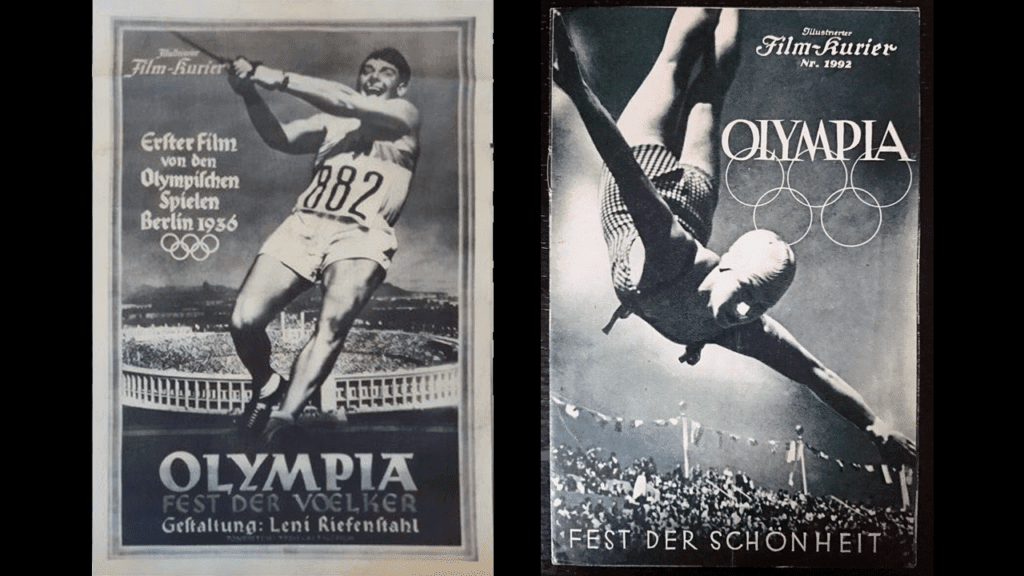
World War II
Hitler’s invasion of Poland in 1939 marked the start of the Second World War, which led to the cancellation of the 1940 Tokyo and 1944 London Olympics. Hitler had once dreamed that the 1940 Olympics would be the last Olympics outside Germany. Future Olympics were to be held in a new reconstructed and expanded Berlin, a capital of the world, were athletes from approved countries would come to compete. Instead, he left Germany and much of Europe in ruins, and left the German people under a curse.
The post-war 1948 London Games symbolized recovery and unity, featuring 59 nations despite the post-war austerity. The Games were dubbed the ‘Austerity Games’ because of Britain’s economic struggles following World War II, including food rationing and shortages of essential goods. The world had gone 12 years without an Olympics, but things did not simply go back to the way they were, with all sides forgiven. The two major powers most responsible for dragging the world into a global conflict, Germany and Japan, were not invited to participate. Despite the many challenges involved, the Games were a success, showcasing remarkable athletic performances and the hinting at positive changes to come.
During these Games, significant innovations included the introduction of starting blocks for sprint races for the first time. American Bob Mathias emerged as a standout star, winning the decathlon just four months after taking up the sport, making him the youngest athlete to win a men’s athletics event in Olympic history. Dutch sprinter Fanny Blankers-Koen dominated the female events, winning four gold medals and earning the title of ‘the Flying Housewife’ in a society that was still very unsure about women’s changing and expanding roles. The London 1948 Olympics captivated audiences and set a hopeful tone for future Olympic competitions, emphasizing themes of resilience and sportsmanship.
Additionally, the 1948 Games saw the birth of the Paralympic movement. On the opening day of the Olympics, Professor Sir Ludwig Guttmann organized the first competition for wheelchair athletes at Stoke Mandeville Hospital in Buckinghamshire. This event, known as the Stoke Mandeville Games, featured 16 injured men and women competing in an archery event, laying the foundation for the Paralympic Games.
Another noteworthy event was the political defection of Marie Provazníková, the Czech President of the International Gymnastics Federation. At the end of the Games, she announced her decision to remain in Britain, unable to accept the communist takeover of Czechoslovakia and the replacement of traditional gymnastic clubs with communist sports festivals. This incident highlighted the broader geopolitical tensions of the time, as wartime allies against the Nazis became enemies again.
1948 also saw the return of the Winter Olympics, officially known as the V Olympic Winter Games, in St. Moritz, Switzerland. St. Moritz had remained neutral and undamaged during the war, which provided a more stable and picturesque setting than London. Twenty-eight countries participated, represented by 669 athletes (592 men and 77 women). Like the Summer Games, Germany and Japan were not invited to compete. Despite the financial and logistical challenges posed by the post-war environment, the Games were well-organized and largely successful. The weather, which had caused significant disruptions during the 1928 Winter Games in St. Moritz, cooperated, resulting in only minor rescheduling. The Games symbolized a return to normalcy and international cooperation after the devastation of World War II, setting the stage for the continued growth and development throughout the globe.
The Cold War
The Cold War era brought a new dimension to the Olympic Games, with geopolitical tensions between the United States and the Soviet Union playing out on the athletic stage. The 1952 Helsinki Games were particularly significant as they marked the first time the Soviet Union participated in the Olympics. This event symbolized the beginning of an intense rivalry that would characterize many subsequent Games. The Soviet Union’s entry into the Olympics introduced a fierce competition, with both superpowers eager to demonstrate their purported superiority not just in political, economic, technological, and military arenas, but also in sports.
The 1952 Winter Olympics in Oslo, Norway, were equally notable for the Soviet Union’s debut in winter sports, further intensifying the competition. This debut was a clear signal of the USSR’s intention to challenge Western dominance in all facets of the Olympic Games. The Soviet athletes, rigorously trained under state-sponsored programs, often dominated many events, pushing the United States and its allies to enhance their own athletic programs.
The 1956 Melbourne Games, the first to be held in the Southern Hemisphere, were marked by significant political turmoil. These Games were notable for several boycotts. Egypt, Iraq, and Lebanon boycotted in protest against the Suez Crisis, where Israel, France, and the United Kingdom tried to solve a dispute over passage through the Suez Canal through force of arms. The Netherlands, Spain, and Switzerland also boycotted in response to the Soviet invasion of Hungary. A major problem arose due to Australia’s strict quarantine laws, forcing the equestrian events to be held in Stockholm, Sweden. Despite these challenges, the Games went on to demonstrate the resilience of the Olympic spirit in the face of adversity.
In 1956, the Winter Olympics in Cortina d’Ampezzo, Italy, made history with the first live television coverage of the Games. This technological advancement allowed millions of people worldwide to witness the competitions in real-time, significantly increasing the Olympics’ global reach and popularity. The exposure also highlighted the growing importance of media in shaping public perception of the Games and the athletes.
The 1960 Rome Games introduced the first official Olympic Village, which set a new standard for athlete accommodation. This innovation provided a centralized location where athletes from different countries could live and interact, fostering a sense of international camaraderie and community. The same year, the Squaw Valley Winter Olympics in the United States featured the debut of biathlon and women’s speed skating, showcasing the evolving nature of Olympic sports and the inclusion of more diverse athletic events.
The 1964 Tokyo Games were the first Olympics held in Asia, and they served as a showcase of Japan’s remarkable post-war recovery and technological advancement. The Tokyo Olympics featured several innovations, including the introduction of the first-ever satellite broadcast, allowing events to be viewed live across different continents.
The 1964 Winter Olympics in Innsbruck, Austria, were faced with unpredictable weather, which required the use of stored snow to ensure the events could proceed. This logistical challenge underscored the complexities of hosting winter sports and the need for contingency planning in Olympic preparations. Despite these challenges, the Innsbruck Games were successful, reinforcing the resilience and adaptability of the Olympic movement.
The 1968 Mexico City Games were notable for their high-altitude location and the significant political statement made by athletes Tommie Smith and John Carlos. During the medal ceremony for the men’s 200 meters, Smith and Carlos raised their fists in a Black Power salute, drawing attention to racial inequality and civil rights issues in the United States. This act of protest was a powerful reminder of the broader social and political issues that intersected with the world of sports, but not everyone saw the Olympics as a platform for advocacy, which is a debate that has continued on in many sports.
The 1968 Winter Olympics in Grenoble, France, introduced the first Olympic mascot, Schuss, a stylized skier, which became a symbol of the Games and a marketing tool. This innovation marked the beginning of a tradition that continues to this day, with each Olympic Games featuring its own unique mascot to embody the spirit of the event and promote it to a global audience.
These developments during the Cold War period not only highlighted the evolving nature of the Olympic Games but also underscored their role as a stage for international diplomacy, technological innovation, and social change. The Games became a microcosm of the broader geopolitical landscape, reflecting the tensions and triumphs of a rapidly changing world that was fast becoming a, “Global Village,” as Marshall McLuhan later dubbed it, thanks to television.
Munich
The 1972 Munich Olympics were intended to symbolize Germany’s transformation from the dark legacy of the 1936 Berlin Games under Nazi rule to a modern, peaceful nation. The organizers hoped these Games would do for Germany what the 1964 Tokyo Games had done for Japan: showcase the country’s recovery and commitment to peace. However, the Munich Games became infamous for one of the greatest tragedies in Olympic history, a nightmare broadcast live to a shocked global audience.
In an effort to distance themselves from any appearance of militarism, the German authorities opted for minimal security measures, avoiding the presence of heavily armed forces. This lack of preparedness had dire consequences. On September 5, 1972, eight Palestinian terrorists from the group Black September infiltrated the Olympic Village and took eleven Israeli athletes hostage. The initial response was chaotic and poorly coordinated, as German police had no specialized anti-terrorism units and were unprepared for such an attack.
The standoff lasted for 21 hours, during which the world watched in horror as negotiations unfolded live on television. Despite the high stakes, the German authorities’ attempts to resolve the crisis were marred by critical errors and misjudgments. The final rescue attempt at Fürstenfeldbruck airbase was disastrously mishandled, resulting in the deaths of all eleven Israeli hostages, one German police officer, and five of the eight terrorists.
In the immediate aftermath, a memorial service was held in the Olympic Stadium, where the remaining Israeli team members and athletes from other nations paid tribute to the victims. However, the decision to continue the Games just a day later was controversial and sparked intense debate about the appropriateness of proceeding in the wake of such a tragedy. While some argued it was a defiant gesture against terrorism, others felt it was a callous disregard for the lives lost.
The bodies of the dead terrorists were flown to Libya, where they received a hero’s welcome from a massive crowd that were literally dancing in the streets. This response contrasted sharply with the grief and outrage felt by many around the world. The aftermath of the tragedy was further complicated when, just two months later, the three surviving terrorists were released by the German government in exchange for hostages taken during the hijacking of Lufthansa Flight 615. This decision, seen as capitulation to terrorist demands, drew widespread condemnation and left many questions about the handling of the crisis. Some now maintain the the entire hijacking was staged to give the Germans an excuse to release their prisoners without a trial.
For a comprehensive and gripping account of the events, I highly recommend the Oscar-winning documentary “One Day in September” (1999). This film provides a detailed and poignant exploration of the Munich massacre, capturing the horror, confusion, and tragic mistakes that defined those fateful days.

Afghanistan
The 1976 Montreal Olympics in Canada were notable for both financial troubles and political unrest. The city faced a significant financial crisis, with costs skyrocketing well beyond the initial budget, leaving Montreal in debt for decades. The Games were also marked by a series of boycotts, with 22 African nations withdrawing to protest the inclusion of New Zealand. The controversy stemmed from New Zealand’s rugby team’s tour of apartheid-era South Africa, which violated the sporting boycott of the country.
The 1980 Moscow Olympics witnessed one of the most significant boycotts in Olympic history. Following the Soviet invasion of Afghanistan in December 1979, the United States led a boycott, refusing to participate in the Games. Over 60 countries joined the boycott, significantly reducing the number of competing nations. Despite this, the Soviet Union hosted a grand event with 80 participating countries and several notable athletic performances. However, the absence of many top athletes from the boycotting nations undeniably cast a shadow over the Games. The Games proceeded with a heavy emphasis on Soviet and Eastern Bloc dominance, but the political tension was palpable, and the spirit of international unity that the Olympics strive to embody was severely undermined.
Meanwhile, the United States and the Soviet Union did face off at the 1980 Winter Olympics in Lake Placid, New York. This led to one of the most memorable moments in sports history, famously known as the “Miracle on Ice.” The US hockey team, composed mainly of amateur and collegiate players, defeated the seemingly invincible Soviet team, which had dominated international hockey for years. The US team’s 4-3 victory in the semifinals captured the imagination of the world and became a symbol of hope and resilience during a time of Cold War tension. The US team went on to win the gold medal, solidifying their place in Olympic lore.
In stark contrast to the Moscow Games, the 1984 Los Angeles Olympics were a commercial triumph, despite a retaliatory boycott led by the Soviet Union and joined by 14 Eastern Bloc countries and allies. The Los Angeles Games were the first privately funded Olympics, and they set a new standard for commercialization and profitability. Corporate sponsorships and extensive media coverage turned the event into a financial success. The Games saw a record 140 nations participating and were marked by numerous memorable performances, including Carl Lewis winning four gold medals in track and field, emulating Jesse Owens’ feat in 1936. The US athletes’ dominant performance and the enthusiastic support from the local and international community helped make the 1984 Olympics a pivotal moment in the history of the Games.
Change and Expansion
As the Eastern Bloc of Soviet-controlled states in Europe began to disintegrate, culminating in the collapse of the Soviet Union in 1991, many aspects of the world, including the Olympics, saw significant changes. The 1988 Seoul Games were notable for the participation of the Soviet Union, which would compete as a unified team for the last time. North Korea, however, boycotted the event, highlighting ongoing geopolitical tensions. The Seoul Games also saw the rise of Ben Johnson, who initially won the 100-meter sprint in a record time, only to be stripped of his medal due to a doping scandal.
The 1992 Barcelona Games were celebrated for their spectacular opening ceremony, which showcased Spanish culture and history. These Games were also notable for the debut of the “Dream Team,” the United States’ basketball team composed of NBA stars, who dominated the competition and brought a new level of excitement to the sport. This year also marked the first time that athletes from the newly independent states of the former Soviet Union competed under their own flags, highlighting the geopolitical shifts of the era.
A significant change during this period was the separation of the Winter and Summer Olympics, a decision made by the International Olympic Committee (IOC) to ensure that the two events would occur in different years. Starting in 1994, the Winter and Summer Games began to be held every two years, rather than both being held every four years in the same calendar year. This allowed for greater focus on each event and more consistent engagement with the Olympics.
The 1996 Atlanta Games were intended to celebrate the centennial of the modern Olympics, but they were marred by a tragic bombing incident in Centennial Olympic Park, which killed two people and injured over a hundred. Despite this, the Games featured memorable performances, such as Michael Johnson’s record-breaking runs in the 200 and 400 meters and the emotional lighting of the Olympic flame by Muhammad Ali.
The 1998 Nagano Winter Games in Japan introduced snowboarding and women’s ice hockey, expanding the range of sports and increasing participation among younger athletes and women. The Games were praised for their organization and the beautiful mountain setting, which provided a stunning backdrop for the competitions.
The 2000 Sydney Games were known for their well-organized events and environmental initiatives, earning them the reputation of being “the best Olympic Games ever” by then-IOC President Juan Antonio Samaranch. Cathy Freeman’s victory in the 400 meters, symbolizing reconciliation and unity in Australia, was a highlight of the Games.
The 2002 Salt Lake City Winter Olympics, held in the aftermath of the September 11 attacks, symbolized resilience and unity. The Games were well-received, with the United States winning an unprecedented number of medals and the events proceeding smoothly despite heightened security concerns.
The 2004 Athens Games saw the Olympics return to their birthplace, with a focus on celebrating history and tradition. The Games were a logistical challenge but ultimately successful, with memorable moments such as the Greek runner Fani Halkia winning gold in the 400-meter hurdles and the marathon finishing in the historic Panathenaic Stadium.
The 2006 Turin Winter Games in Italy were known for their vibrant cultural celebrations and the inclusion of new events like snowboard cross. These Games highlighted the blending of sport and culture, with the host city showcasing its rich heritage.
The 2008 Beijing Games were marked by grandiose opening and closing ceremonies and China’s emergence as a global power. The Games saw extraordinary performances, including Michael Phelps winning eight gold medals in swimming and Usain Bolt setting world records in the 100 and 200 meters.
The 2012 London Games featured innovative technology and strong performances by the host nation, particularly in cycling, rowing, and athletics. The opening ceremony, directed by Danny Boyle, was a celebration of British culture and history, and the Games were widely praised for their organization and enthusiasm.
The 2014 Sochi Winter Games in Russia were marred by political controversies and security concerns, especially regarding the situation in Ukraine and the threat of terrorism. Despite these issues, the Games were notable for their impressive venues and the dominance of Russian athletes.
The 2016 Rio de Janeiro Games faced numerous challenges, including economic instability, environmental issues, and concerns about the Zika virus. However, the Games also showcased the spirit and resilience of the athletes and the people of Brazil. Highlights included Simone Biles’ stunning gymnastics performances and the historic achievement of the Refugee Olympic Team.
The 2018 PyeongChang Winter Olympics in South Korea were notable for the diplomatic efforts between North and South Korea, with athletes from both nations marching together under a unified flag during the opening ceremony. These Games also saw the introduction of new sports such as big air snowboarding and mass start speed skating, reflecting the evolving nature of the Winter Olympics.
The Future
The 2020 Tokyo Summer Games faced unprecedented challenges due to the COVID-19 pandemic, leading to their postponement to 2021. This marked the first time in Olympic history that the Games were delayed rather than canceled. The event took place with significant health and safety measures in place, including daily testing for athletes, strict quarantine protocols, and no live audiences. The absence of spectators created a unique and surreal atmosphere, with athletes performing in empty stadiums, while the world watched from home. Despite these challenges, the Games showcased remarkable athletic performances and moments of resilience, such as the mutual support between high jumpers Mutaz Essa Barshim of Qatar and Gianmarco Tamberi of Italy, who chose to share the gold medal.
The 2022 Beijing Winter Games were overshadowed by geopolitical tensions and concerns over human rights issues in China, particularly regarding the treatment of Uyghur Muslims in Xinjiang. Several countries, including the United States, announced a diplomatic boycott of the Games, though their athletes still competed. The event also faced challenges related to the COVID-19 pandemic, with strict bubble protocols to prevent outbreaks. Despite these issues, the Games featured impressive performances and technological advancements, such as the use of artificial snow to ensure optimal conditions for the events.
The ongoing Olympics in Paris began with a beautifully executed opening ceremony. Despite heavy rain, the event was celebrated for taking the ceremony outside the traditional stadium setting, showcasing iconic locations throughout the city. This innovative approach highlighted Paris’s cultural and historical landmarks, creating a visually stunning spectacle. However, in a true sign of our times, a rapid and irrational backlash erupted on social media. Many people on the political right called for a boycott as absurd claims about Satanic pedophiles running the world and hidden messages in the ceremony circulated wildly. Despite these unfounded accusations, the Games have proceeded smoothly, with athletes and spectators alike enjoying the events.
As of 2024, there are 33 sports with 339 events in the Summer Games and 15 sports with 109 events in the Winter Games. The scope and scale of the Olympics continue to grow, reflecting the expanding interests and capabilities of athletes worldwide. The future of the Olympics is likely to bring further changes and innovations, shaped by global developments and societal shifts. New sports may be introduced, and efforts to make the Games more sustainable and inclusive will likely continue. Despite the challenges and controversies, the Olympics remain a powerful symbol of unity and peace, celebrating human achievement and resilience. The Games will undoubtedly continue to evolve, maintaining their relevance and inspiring future generations of athletes and fans around the world.
Recommendations
Want to know more or explore a particular aspect of Olympic History? Here is a list of books and movies to get you started:
Books:
“The Games of 1896: The First Modern Olympics” by Richard D. Mandell: An in-depth look at the inaugural modern Olympics and its historical significance.
“The Games: A Global History of the Olympics” by David Goldblatt: A comprehensive history of the Olympic Games, exploring their impact on global culture and politics.
“The Olympic Games: The First Hundred Years” by the International Olympic Committee: A visual history of the Olympics, showcasing significant moments and developments.
“The Olympics: A History of the Modern Games” by Allen Guttmann: A detailed account of the Olympics’ evolution, highlighting key moments and controversies.
“The Boys in the Boat” by Daniel James Brown: The inspiring story of the American rowing team that competed in the 1936 Berlin Olympics.
“Jesse Owens: A Biography” by William J. Baker: An insightful look into the life of the athlete who defied Nazi ideology and won four gold medals at the 1936 Berlin Olympics.
Films:
“Chariots of Fire” (1981) directed by Hugh Hudson: A classic film that tells the story of two British athletes competing in the 1924 Paris Olympics, focusing on themes of perseverance and faith.
“Olympia 1. Teil — Fest der Völker” (Festival of Nations) and “Olympia 2. Teil — Fest der Schönheit” (Festival of Beauty) directed by Leni Riefenstahl: Despite its propagandistic roots, this film is notable for its pioneering techniques in sports cinematography and provides insight into how the 1936 Berlin Olympics were used inappropriately for propaganda purposes.
“One Day in September” (1999) directed by Kevin Macdonald: A gripping documentary about the Munich massacre, offering a detailed account of the tragic events.
“Icarus” (2017) directed by Bryan Fogel: A documentary exploring doping in sports, particularly related to the Russian scandal, and its implications for the Olympics.

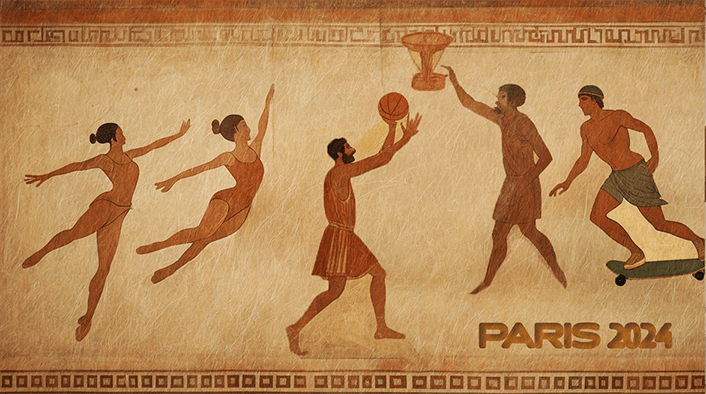

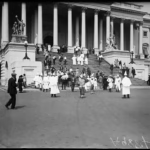
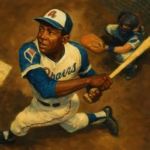


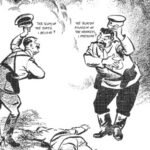





Leave a Reply